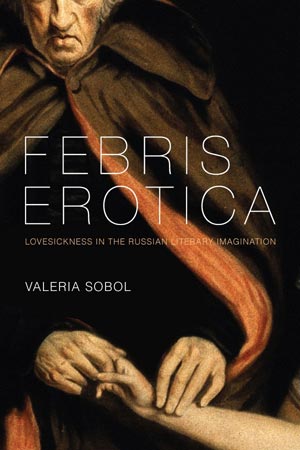
This book is about the cultural connection between love and illness—a connection often referred to in the everyday use as “lovesickness” and all too often automatically assumed. As a specialist in and a long-time devotee of nineteenth-century Russian literature, I encountered time and again, almost in every nineteenth-century Russian novel, a hero or a heroine who falls ill or even dies from unrequited or unfulfilled love. I became curious about the scientific, philosophical, and cultural assumptions that underlie that recurrent cliché: indeed, in order to portray a heroine who develops tuberculosis as a result of illicit passionate love, in order to link an emotional distress directly to a bodily illness, one must have a certain vision of the interaction between the two realms in the human being—physical, on the one hand, and “spiritual” or emotional, on the other.
Febris Erotica reconstructs this vision and offers a cultural history of “lovesickness,” as both a literary and a medical concept, first in the West and then in early modern Russia. Then I turn to its ubiquitous presence in nineteenth-century Russian novels. I argue that Russian writers so frequently have recourse to this cliché because of its serious philosophical and epistemological implications. The idea that unconsummated or unreturned passion can cause a physical disorder and, more broadly, that bodily symptoms can serve as a means to read the life of the psyche assumes relationships between mind and body, between strong emotions and somatic ailments, and, at another level, between the exterior and the interior, the revealed and the concealed.
Febris Erotica shows that for various reasons the nature of these relationships deeply preoccupied Russian writers. Their persistent use of lovesickness was not an automatic deployment of a traditional theme but, rather, a way to address pressing philosophical, ethical and, in some cases, ideological concerns through a recognizable literary convention. The history of lovesickness in Russian literature is entwined in this study with the intellectual and cultural history of Russia of the late eighteenth and nineteenth centuries. I demonstrate a complex and symbiotic relationship between literature and medicine—or more broadly, between scientific and cultural developments—in the era where the two, far more so than today, were closely linked.
“My analysis places the literary tradition of lovesickness into the broader context of the mind-body dilemma that plagued Western culture at least since antiquity and became particularly poignant after Descartes.”
Contrary to what some readers may assume, this book arose not from a personal experience of lovesickness but rather from an intellectual and academic engagement with the dialogue between literature and medicine.
Not having any medical training, I nonetheless became fascinated by the persistent presence of medical metaphors, imagery, and themes in Russian literature of certain transitional periods. It soon became clear to me that this medical discourse almost always played a strategic role in literary texts—it invoked a materialist outlook that typically advocated a reductive, purely physical model of the human being. This was particularly prominent in the numerous literary scenes of lovesickness where the character’s inner trauma, usually known to the reader, remained inaccessible to the fictional medical professional who treated the condition as a purely somatic disorder and thus revealed the limitations of the reductionist, body-centered view.
My analysis, then, places the literary tradition of lovesickness into the broader context of the mind-body dilemma that plagued Western culture at least since antiquity and became particularly poignant after Descartes, with his dualist view of the physical and mental spheres as completely independent.
For the Russians, however, even more was at stake: Russia’s belated entry into the Western cultural scene as a result of Peter the Great’s reform in the early eighteenth century meant that the culture of romantic love and the literature of lovesickness arrived as Russia was exposed to Western philosophical and scientific ideas. The literary (and medical) portrayals of passionate love and the suffering produced by it became infused with the scientific problems that were at the forefront of Western European science and philosophy—such as “sensibility,” the anatomical location of the soul, the mind-body relationship, and the physiology of emotions. By the second half of the nineteenth century, when the strong Russian moral and religious tradition found itself threatened by increasing political radicalism and materialist philosophy, these problems had assumed serious ideological overtones.
It is important to realize that in a nineteenth-century Orthodox Christian monarchy, which Russia was at the time, science was not a neutral and independent sphere. Even more so than today (recall disputes over evolution theory), scientific developments carried important ideological, political, and philosophical implications. This was especially true of physiology and medicine—disciplines that dealt with human beings and posed the threat of reducing them to mere physical-chemical compounds.
The problematic status of the soul in experimental physiology and medicine brought these disciplines to the center of religious and metaphysical debates. These concerns were not purely theoretical: as late as in the 1860s, for example, at the height of the development of positivist science, court actions were taken against the prominent Russian physiologist Ivan Sechenov (generally recognized as a precursor to Pavlov) for his study of the reflexes of the brain. Research in physiology, in other words, quickly became associated with radical political views.
In my book I use this historical context as a sort of a cultural code through which I read literary developments and particular texts, which then acquire new levels of complexity and frequently entirely different meanings. The polemics over the boundaries and methods of the positivist inquiry into human nature, the “questions of the soul,” the problem of the mind-body interaction were consistently spilling over from religious, philosophical, and scientific debates onto the pages of the Russian novels. Here the lovesickness convention came particularly handy—a “malady of the soul” that manifested itself in misleading somatic symptoms, it could be, and often was, used to challenge a purely physical view of the human being without disrupting the plot movement and without forcing the author to resort to a nonfictional philosophical digression. The banal scenes at the bedside of lovesick girls and young men, in other words, rather than merely reproducing a familiar cliché, responded to pressing contemporaneous concerns and anxieties. Febris Erotica thus traces critical paradigm shifts in the realm of ideas by focusing on a “case history” of a literary-medical concept.
The book is divided into three larger parts that stress the nature of lovesickness as a medical problem: “Anatomy,” “Diagnostics,” and “Therapy.” The introductory chapter, “Cases in History” offers a brief history of the development of lovesickness both as a literary convention and as a medical concept first in the West and then in Russia. This chapter can serve as a good starting point for the reader because it lays out the scientific and literary background against which I later examine cases in greater detail and simply because in itself it is a rather amusing and fascinating history of the attempts to rationalize and assign a scientific, physiological basis to the psychological distress caused by unrequited or unconsummated love.
Among literary analyses, Chapter 7, “From Lovesickness to Shamesickness: Tolstoy’s Solution,” can be of particular interest to readers—not only because it deals with a well-known literary work, Tolstoy’s famous novel Anna Karenina, but primarily because Tolstoy’s treatment (both literary and medical) of lovesickness is perhaps the most interesting, complex, and full of surprises. Here I examine the case of Kitty’s illness and recovery in Anna Karenina, which on the surface seems to be the rather trivial distress of a young, inexperienced girl who rejected the proposal of a more worthy man in favor of the less worthy one who had no intention of marrying her. In portraying this case, Tolstoy shows everything that is problematic with the lovesickness situation—above all, how it is hard to “read,” how it slips away from the overconfident diagnostic gaze of a medical professional, how an attempt to reduce the patient’s problem to a bodily disorder distorts and simplifies the complex psychological drama that causes the malady.
But Tolstoy takes a step further and dismantles the very tradition of lovesickness. Behind the traditional, almost iconic lovesickness situation—a patient, her grieving family members, and the ignorant doctors—lurks a deeper moral trauma of a high society girl gnawed by shame over her participation in the questionable sexual and social practices of the beau monde which essentially covertly prostitutes young girls in their search for a desirable match.
The “illness” Tolstoy portrays thus is not lovesickness but shamesickness. And it is cured not by the traditional therapeutic means but by a painful and intense inner search for an authentic selfhood. The use of the familiar lovesickness situation thus not only allows Tolstoy to critique the one-sided, positivist model of the human being advanced by some of the doctors treating his heroine and so many of his real-life contemporaries; it enables him to address pressing social and moral questions concerning the status of women in society and to suggest the necessity of a moral search for one’s authentic self.
By substituting shamesickness for the traditional lovesickness, moreover, Tolstoy implicitly challenges Western “romantic” culture and values by insisting that it is not romantic passion but, instead, an intense feeling of inadequacy that can and should be devastating for a human being that seeks moral perfection.
“By substituting shamesickness for the traditional lovesickness, Tolstoy challenges Western “romantic” culture and values by insisting that it is not romantic passion but, instead, an intense feeling of inadequacy that can and should be devastating for a human being that seeks moral perfection.”
When I first embarked on this project, at its early dissertation stage, my advisors urged me to make sure not to look like “yet another girl who is writing about love.” Indeed, in our society that takes pride in its rational and pragmatic ethos, the study of emotions, love among them, could be viewed as academically questionable and intellectually inferior. I hope that this book demonstrates how intellectually engaging it can be to study the cultural constructions of emotions. Even the most inward feelings are inextricably entwined with social, public, and historical matters, and are subject to cultural interpretation.
The attitude to the study of emotions began to change in the last couple of decades, with what has been labeled an “affective turn” or “emotional turn” in the humanities and social studies. Since this turn, a number of conferences have been dedicated to emotions, and books have been written on the subject by anthropologists, historians, sociologists, psychologists, literary scholars and representatives of other disciplines.
Febris Erotica contributes to this growing body of research—and it also brings together several disciplines, showing how a focused analysis of literary representations of a canonical emotional distress leads to new insights concerning some fundamental cultural anxieties and preoccupations.


Valeria Sobol is Associate Professor of Slavic Languages and Literatures at the University of Illinois, Urbana-Champaign. In addition to Febris Erotica, she is the author of articles on eighteenth- and nineteenth-century Russian literature on topics ranging from Russian Sentimentalism to Herzen, Tolstoy, and Chekhov. She is currently co-editing a volume of essays entitled Interpreting Emotions in Russia and Eastern Europe.